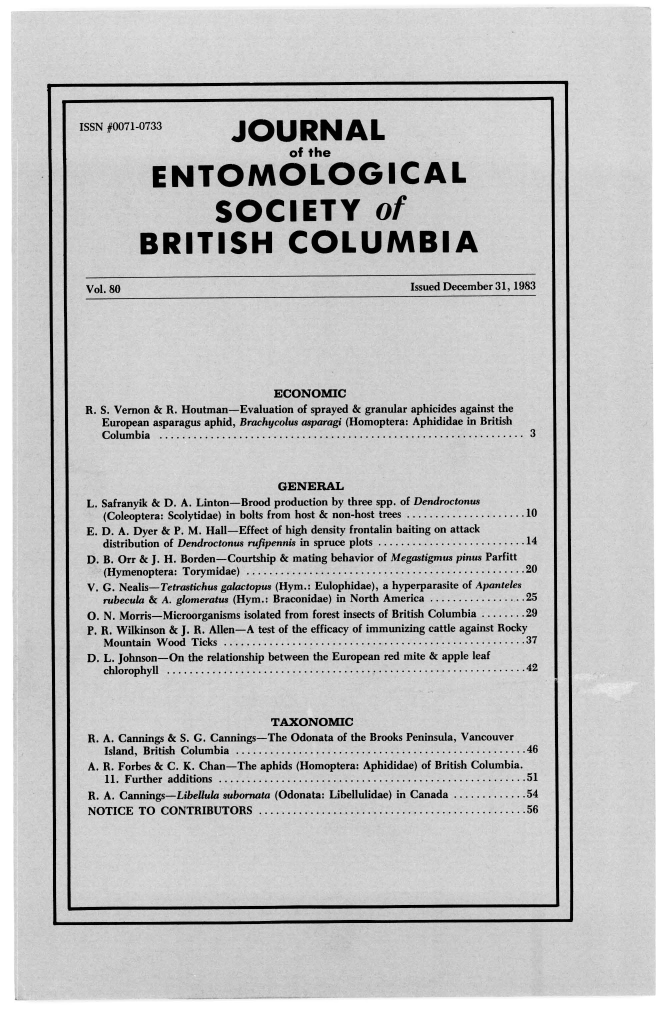A test of the efficacy of immunizing cattle against Rocky Mountain wood ticks
Abstract
Nine yearling steers were inoculated with an extract of <i>Dermacentor variabilis</i> (Say) suspended in aluminum hydroxide adjuvant in an attempt to increase their resistance to the feeding of <i>Dermacentor andersoni</i> Stiles. However, when these cattle were infested with <i>D. andersoni</i> ticks, there were no significant differences in the proportions of ticks feeding, or mean weights of fed ticks, in comparison with nine cattle treated with adjuvant only, or with two untreated cattle. Five of the cattle in each of the treated groups received additional ticks to test for susceptibility to tick paralysis. Three of the cattle treated with tick extract became paralysed. as did one of the cattle treated with adjuvant only. Serological responses to the immunizing antigen, assayed by indirect haemaglutination, were relatively weak. Some possible reasons for the ineffectiveness of the immunization, in contrast to earlier positive studies with guinea pigs and a few cattle, are discussed. The methods described should contribute to testing the practical efficacy of promising antigens as they are produced.
References
Allen, J.R. and S.J. Humphreys. 1979, Immunization of guinea pigs and cattle against ticks. Nature 280:491-493.
Brossard, M. and P. Girardin. 1979. Passive transfer of resistance in rabbits infested with adult Ixodes ricinus L..: Humoral factors influencing feeding and egg laying. Experientia 35:1395-1397.
Costello, R.A. and M.A. Khan. 1980. Control of insects and ticks on livestock. British Columbia Ministry of Agriculture, Victoria, B.C>
C.S.I.R.0. 1983. Ann. Rept. Div. An. Hlth. 1982. Commonwealth Scientific and Industrial Research Organization, Melbourne, Australia. p. 35.
Gregson, J.D. 1966. Records of tick paralysis in British Columbia. J. Entomol. Soc. B.C. 63:13-18.
McTier, T.L., J.E. George, and S.N. Bennett. 1981. Resistance and cross-resistance of guinea pigs to Dermacentor andersoni Stiles, D. variabilis (Say), Amblyomma americanum (Linnaeus), and Ixodes scapularis Say. J. Parasitol. 67:813-822.
Trager, W. 1939. Acquired immunity to ticks. J. Parasitol. 25:57-81.
Wikel, S.K. and J.R. Allen. 1982. Immunological basis of host-resistance to ticks. Pp. 169-196. In: F.D. Obenchain, and R. Galun (Eds). Physiology of ticks. Pergamon Press, Oxford.
Wikel, S.K. and R.L. Osburn. 1982. Immune responsiveness of the bovine host to repeated low-level infestations with Dermacentor andersoni. Ann. Trop. Med. Parasit. 76:405-414.
Wilkinson, P.R. 1968. Phenology, behavior, and host relations of Dermacentor andersoni Stiles in outdoor ‘rodentaria’ and in nature. Can. J. Zool. 46:677-689.
Wilkinson, P.R. 1972. Sites of attachment of 'Prairie' and 'Montane' Dermacentor andersoni (Acarina: Ixodidae) on cattle. J. Med. Ent. 9:133-137.
Wilkinson, P.R. 1973. Termination of diapause in laboratory-reared Dermacentor andersoni adults. Proc. 3rd Int. Congr. Acarol. (Prague 1971) pp. 803-806.
Wilkinson, P.R. 1981. Field test of phosmet and chlorpyrifos formulations for prevention of tick paralysis of cattle. Pesticide Research Report 1980. E.C.P.U.A., Agriculture Canada, Ottawa.
Wilkinson, P.R. 1982. Paralysis by Rocky Mountain Wood Ticks (Acari: Ixodidae) of cattle breeds other than Hereford. J. Med. Ent. 19:215-216.
Downloads
Published
Issue
Section
License
Authors who publish with the Journal of the Entomological Society of British Columbia agree to the following terms:
-Authors retain copyright and grant the journal right of first publication with the work simultaneously licensed under a Creative Commons Attribution License that allows others to share the work with an acknowledgement of the work's authorship and initial publication in this journal.
-Authors are able to enter into separate, additional contractual arrangements for the non-exclusive distribution of the journal's published version of the work (e.g., post it to an institutional repository or publish it in a book), with an acknowledgement of its initial publication in this journal.
-Authors are permitted and encouraged to post their work online (e.g., in institutional repositories or on their website) prior to and during the submission process, as it can lead to productive exchanges, as well as earlier and greater citation of published work (See The Effect of Open Access).


